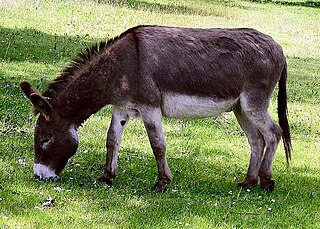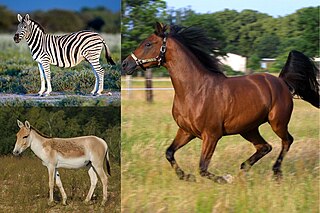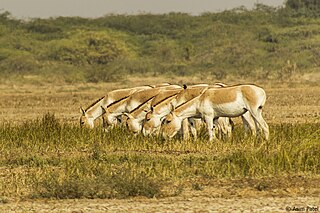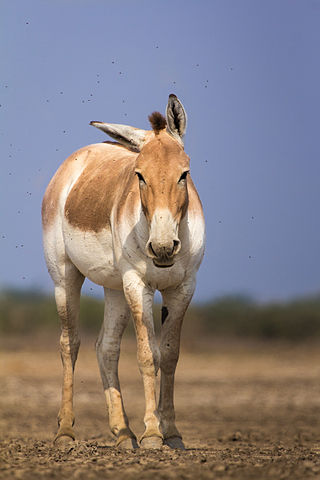Related Research Articles

Equidae is the taxonomic family of horses and related animals, including the extant horses, asses, and zebras, and many other species known only from fossils. The family evolved around 50 million years ago from a small, multi-toed ungulate into larger, single-toed animals. All extant species are in the genus Equus, which originated in North America. Equidae belongs to the order Perissodactyla, which includes the extant tapirs and rhinoceros, and several extinct families.

The donkey is a domesticated equine. It derives from the African wild ass, Equus africanus, and may be classified either as a subspecies thereof, Equus africanus asinus, or as a separate species, Equus asinus. It was domesticated in Africa some 5000–7000 years ago, and has been used mainly as a working animal since that time.

The onager, also known as hemione or Asiatic wild ass, is a species of the family Equidae native to Asia. A member of the subgenus Asinus, the onager was described and given its binomial name by German zoologist Peter Simon Pallas in 1775. Six subspecies have been recognized, two of which are extinct.

Mesquite is a common name for several plants in the genus Prosopis, which contains over 40 species of small leguminous trees. They are native to dry areas in the Americas. They have extremely long roots to seek water from very far under ground. As a legume, mesquites are one of the few sources of fixed nitrogen in the desert habitat. The trees bloom from spring to summer. They often produce fruits known as "pods". Prosopis spp. are able to grow up to 8 metres (26 ft) tall, depending on site and climate. They are deciduous and depending on location and rainfall have either deep or shallow roots. Prosopis is considered long-lived because of the low mortality rate after the dicotyledonous stage and juveniles are also able to survive in conditions with low light and drought. The Cahuilla indigenous people of western North America were known to eat the seeds of mesquite.
The Bakanambia, also known as the Wanbara, are an Aboriginal group of Australia. Traditionally, the Bakanambia lived in the vicinity of Princess Charlotte Bay in the state of Queensland. One of the ethnonyms applied to them was Lama Lama, which is now used of a larger aggregation of remnants of several tribes.

The Metamorphoses of Apuleius, which Augustine of Hippo referred to as The Golden Ass, is the only ancient Roman novel in Latin to survive in its entirety.

Equus is a genus of mammals in the family Equidae, which includes horses, asses, and zebras. Within the Equidae, Equus is the only recognized extant genus, comprising seven living species. Like Equidae more broadly, Equus has numerous extinct species known only from fossils. The genus most likely originated in North America and spread quickly to the Old World. Equines are odd-toed ungulates with slender legs, long heads, relatively long necks, manes, and long tails. All species are herbivorous, and mostly grazers, with simpler digestive systems than ruminants but able to subsist on lower-quality vegetation.

The Little Rann of Kutch is a salt marsh which is part of the Rann of Kutch in Kutch district, Gujarat, India.

The Mongolian wild ass, also known as Mongolian khulan, is the nominate subspecies of the onager. It is found in southern Mongolia and northern China. It was previously found in eastern Kazakhstan and southern Siberia before being extirpated there through hunting. As of 2015, the Mongolian wild ass is listed as Near Threatened by the IUCN. Current population estimates are approximately 42,000 individuals in Mongolia and around 5,000 individuals in Northern China.

The African wild ass or African wild donkey is a wild member of the horse family, Equidae. This species is thought to be the ancestor of the domestic donkey, which is sometimes placed within the same species. They live in the deserts and other arid areas of the Horn of Africa, in Eritrea, Ethiopia and Somalia. It formerly had a wider range north and west into Sudan, Egypt, and Libya. It is Critically Endangered, with about 570 existing in the wild.

The Somali wild ass is a subspecies of the African wild ass.

The Indian Wild Ass Sanctuary, or Wild Ass Wildlife Sanctuary, is located in the Little Rann of Kutch in the state of Gujarat, India, spread over an area of 4954 km².

Asinus is a subgenus of Equus that encompasses several subspecies of the Equidae commonly known as wild asses, characterized by long ears, a lean, straight-backed build, lack of a true withers, a coarse mane and tail, and a reputation for considerable toughness and endurance.

The Syrian wild ass, less commonly known as a hemippe, an achdari, or a Mesopotamian or Syrian onager, is an extinct subspecies of onager native to the Arabian peninsula and surrounding areas. It ranged across present-day Iraq, Palestine, Israel, Iran, Jordan, Saudi Arabia, Syria, and Turkey.

The Indian wild ass, also called the Indian onager or, in the local Gujarati language, Ghudkhur and Khur, is a subspecies of the onager native to South Asia.

The Atlas wild ass, also known as Algerian wild ass, is a purported extinct subspecies of the African wild ass that was once found across North Africa and parts of the Sahara.

The Nubian wild ass is the nominate subspecies of African wild ass, and one of the ancestors of the domestic donkey, which was domesticated about 6,000 years ago. It is presumed to be extinct, though two populations potentially survive on the Caribbean island of Bonaire and in Gebel Elba.

Bad Ass is a 2012 American action film written and directed by Craig Moss. The film stars Danny Trejo, Charles S. Dutton, and Ron Perlman. It is loosely based on the 2010 AC Transit Bus fight viral video.
Barry Kingham Oakley is an Australian writer.
This article presents a list of the historical events and publications of Australian literature during 1967.
References
- ↑ Ed. Scott Murray, Australia on the Small Screen 1970-1995, Oxford Uni Press, 1996 p164